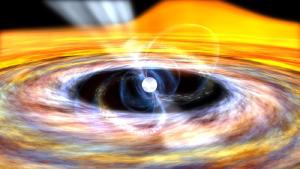Post
Eat and Run
27 September 2013
 NASA/Goddard Space Flight Center/Dana Berry
NASA/Goddard Space Flight Center/Dana BerryA millisecond pulsar is a neutron star that is rotating about 600 to 700 times a second. Because of their strong magnetic fields, they produce strong beams of radio energy from the regions of their magnetic poles, and as they rotate these beams can point in our direction. As a result, we observe these neutron stars as radio bursts that pulse every 1 – 10 milliseconds. Hence their name.
Millisecond pulsars are rotating about as fast as neutron star can rotate, which makes them a bit of a mystery. Left by themselves, a pulsar gradually slows down over time. That means millisecond pulsars are either very young neutron stars that formed at near maximal rotation, or there must be some mechanism that causes them to spin more rapidly.
It’s generally thought that the latter process is the more common. A neutron star that is part of a binary system with a red giant companion can capture material from the companion star. As the material is captured, the angular momentum (rotation) of the material is transferred to the neutron star, thus increasing its rotation. This would explain why millisecond pulsars are often old pulsars with a companion. While this mechanism was initially proposed decades ago, over the years we’ve gathered a lot of evidence to support it.
When neutron stars are actively capturing material from their companion, the energy released as it falls to the neutron star produces intense x-rays. Such x-ray producing systems are known as x-ray binaries. These x-ray binaries can be quite active, but the radiation emitted by them tends to push the accreting material away. Thus over time an active x-ray binary will become less active, eventually entering a quiet period after which it may become active again. In the late 1980s it was observed that some x-ray binaries in the late stage of their active period contain radio millisecond pulsars.1 In 1998 a millisecond pulsar was observed within an active x-ray binary.2 Then in 2009 an accretion disk was discovered around a millisecond pulsar, indicating that the pulsar had been accreting material in the past.3
Then last year in Nature new evidence was presented that further verifies the mechanism.4 The paper presents observations of an x-ray transient known as IGR J18245–2452. An x-ray transient is an object that emits x-rays for a time, then goes quiet for a time. There are several types of x-ray transients, but this particular one is a neutron star with a companion. In the past it had been observed as a radio pulsar. It then entered an active period and begin emitting x-rays with millisecond pulsations. After an active period of about a month, the x-rays went quiet, and the neutron star began to emit radio pulses again.
This not only demonstrates a clear connection between x-ray binaries and millisecond pulsars, but that these objects can shift between the two states on a fairly rapid pace. It seems that some neutron stars really do eat and run.
Backer, D. Cꎬ, et al. “A millisecond pulsar.” Nature 300.5893 (1982): 615-618. ↩︎
Wijnands, Rudy, and Michiel van der Klis. “A millisecond pulsar in an X-ray binary system.” Nature 394.6691 (1998): 344-346. ↩︎
Archibald, Anne M., et al. “A radio pulsar/X-ray binary link.” Science 324.5933 (2009): 1411-1414. ↩︎
Papitto, Alessandro, et al. “Swings between rotation and accretion power in a binary millisecond pulsar.” Nature 501.7468 (2013): 517-520. ↩︎